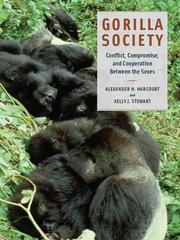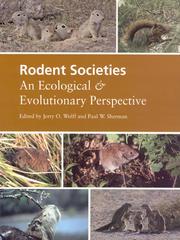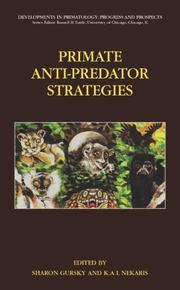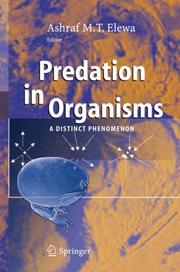| Listing 1 - 6 of 6 |
Sort by
|

ISBN: 128090173X 9786610901739 1402056761 1402056753 9048174236 Year: 2007 Publisher: Dordrecht : Springer Netherlands : Imprint: Springer,
Abstract | Keywords | Export | Availability | Bookmark
 Loading...
Loading...Choose an application
- Reference Manager
- EndNote
- RefWorks (Direct export to RefWorks)
Defending Life discusses the relationship between hosts and parasites. A major contention of the book is that the immune system depends ontologically on the ecosystem in which it is embedded; it would not have the features it has if it was not related in one way or other to parasitic agents and to the host’s own cells and tissues. To sustain the argument, life is investigated at all layers – from molecules up through cells, organisms and ecosystems. Together with the inverse course, which goes from ecological contingencies down to gene-expression profiles, the approach facilitates an advanced understanding of immunocompetence as well as its converse, immunoincompetence. The emphasis on analytical abstractions, coherent patterns and generative mechanisms makes possible the distinction between genuine causality and coincidental associations, and thus increases the understanding of why we observe what we observe. The book contains detailed descriptions of the immune system and the microbial world as well as methodological and conceptual clarifications. "The book is highly recommended to those who want to dig into the scientific challenges involved in understanding the complex demands and tasks that nature had bestowed the immune system. " Professor Roland Jonsson The Gade Institute, University of Bergen, Norway.
Host-parasite relationships --- Parasitism. --- Immunological aspects. --- Parasites --- Parasitology --- Predation (Biology) --- Immunology. --- Life sciences. --- Microbiology. --- Biology-Philosophy. --- Life Sciences, general. --- Medical Microbiology. --- Philosophy of Biology. --- Biology --- Philosophy. --- Vitalism --- Microbial biology --- Microorganisms --- Biosciences --- Sciences, Life --- Science --- Immunobiology --- Life sciences --- Serology --- Medical microbiology. --- Biology—Philosophy.

ISBN: 1281957089 0226316041 9786611957087 9780226316048 9780226316024 0226316025 9780226316031 0226316033 9781281957085 6611957081 Year: 2007 Publisher: Chicago : University of Chicago Press,
Abstract | Keywords | Export | Availability | Bookmark
 Loading...
Loading...Choose an application
- Reference Manager
- EndNote
- RefWorks (Direct export to RefWorks)
Societies develop as a result of the interactions of individuals as they compete and cooperate with one another in the evolutionary struggle to survive and reproduce successfully. Gorilla society is arranged according to these different and sometimes conflicting evolutionary goals of the sexes. In seeking to understand why gorilla society exists as it does, Alexander H. Harcourt and Kelly J. Stewart bring together extensive data on wild gorillas, collected over decades by numerous researchers working in diverse habitats across Africa, to illustrate how the social system of gorilla
Gorilla --- Social behavior in animals. --- Animal behavior --- Animal societies --- Gorilla gorilla --- Gorillas --- Lowland gorilla --- Western gorilla --- Gorilla (Genus) --- Behavior. --- Ecology. --- gorilla, animal behavior, animals, africa, social system, ecology, biology, science, zoology, nature, environment, conflict, compromise, cooperation, gender, conservation, preservation, habitat, jungle, endangered, environmentalism, species, reproduction, survival, evolution, primate, socioecology, grouping, predation, mating, infanticide, body size, sexual dimorphism, pan, pongo, nonfiction, harassment, roving males, emigration.

ISBN: 0226905381 128196686X 9786611966867 9780226905389 9781281966865 9780226905365 0226905365 9780226905372 0226905373 Year: 2007 Publisher: Chicago : The University of Chicago Press,
Abstract | Keywords | Export | Availability | Bookmark
 Loading...
Loading...Choose an application
- Reference Manager
- EndNote
- RefWorks (Direct export to RefWorks)
Rodent Societies synthesizes and integrates the current state of knowledge about the social behavior of rodents, providing ecological and evolutionary contexts for understanding their societies and highlighting emerging conservation and management strategies to preserve them. It begins with a summary of the evolution, phylogeny, and biogeography of social and nonsocial rodents, providing a historical basis for comparative analyses. Subsequent sections focus on group-living rodents and characterize their reproductive behaviors, life histories and population ecology, genetics, neuroendocrine mechanisms, behavioral development, cognitive processes, communication mechanisms, cooperative and uncooperative behaviors, antipredator strategies, comparative socioecology, diseases, and conservation. Using the highly diverse and well-studied Rodentia as model systems to integrate a variety of research approaches and evolutionary theory into a unifying framework, Rodent Societies will appeal to a wide range of disciplines, both as a compendium of current research and as a stimulus for future collaborative and interdisciplinary investigations.
Rodents --- Social behavior in animals. --- Animal societies. --- Social behavior in animals --- Animal behavior --- Animal societies --- Rodentia --- Mammals --- Ecology. --- Evolution. --- social behaviour --- rodents, social behavior, ecology, conservation, population management, environment, nonfiction, science, nature, biogeography, reproduction, diseases, socioecology, antipredator strategies, predation, cooperation, communication, cognition, behavioral development, neuroendocrine mechanisms, genetics, biology, evolution, mating, sexual selection, breeding, tree squirrels, stress, dimorphism, sex ratio, kin recognition, adaptation, foraging, blind mole rats, beaver, prairie dogs, infanticide, capybaras.

ISBN: 128090139X 9786610901395 0387348107 0387348077 1441941908 Year: 2007 Publisher: New York, NY : Springer US : Imprint: Springer,
Abstract | Keywords | Export | Availability | Bookmark
 Loading...
Loading...Choose an application
- Reference Manager
- EndNote
- RefWorks (Direct export to RefWorks)
Since the 1960s, primatologists have recognized the impact of predation on the evolution of morphology, the social systems and cognitive behavior of monkeys and apes, but few studies considered its impact on the prosimians - lemurs, lorises, galagos and tarsiers. This comprehensive volume, written by experts in the field, narrows this gap by highlighting the effect of predation on the order Primates in general. Theoretical approaches to understanding how primates perceive predation threat, as well as proximate and ultimate causes to address threat and attack, are considered across the primate order. Although this volume concentrates on the least known group in this theoretical area - the prosimians - contributions by researchers on numerous primate taxa across four major geographical regions make this a novel and exciting contribution to students interested in primate evolution and ecology.
Life sciences. --- Behavioral sciences. --- Developmental biology. --- Ecology. --- Zoology. --- Anthropology. --- Life Sciences. --- Behavioral Sciences. --- Developmental Biology. --- Human beings --- Biology --- Natural history --- Animals --- Balance of nature --- Bionomics --- Ecological processes --- Ecological science --- Ecological sciences --- Environment --- Environmental biology --- Oecology --- Environmental sciences --- Population biology --- Development (Biology) --- Growth --- Ontogeny --- Biosciences --- Sciences, Life --- Science --- Ecology --- Prosimians --- Patas monkey --- Howler monkeys --- Cercopithecus aethiops --- Chacma baboon --- Predation (Biology) --- Effect of predation on. --- Communities, Predator-prey --- Dynamics, Predator-prey --- Interactions, Predator-prey --- Predator-prey communities --- Predator-prey dynamics --- Predator-prey interactions --- Predator-prey relations --- Predator-prey relationships --- Predator-prey systems --- Predators and prey --- Predatory behavior (Biology) --- Predatory-prey relationships --- Prey and predators --- Prey-predator relationships --- Preying (Biology) --- Relations, Predator-prey --- Relationships, Predator-prey --- Systems, Predator-prey --- Animal ecology --- Parasitism --- Chaeropithecus ursinus --- Papio ursinus --- Papio --- Cercopithecus pygerythrus --- Cercopithecus sabaeus --- Cercopithecus tantalus --- Green monkey --- Grivet monkey --- Savanna monkey --- Vervet monkey --- Cercopithecus --- Erythrocebus patas --- Hussar monkey --- Red guenon --- Erythrocebus --- Alouatta --- Howling monkeys --- Atelidae --- Lower primates --- Prosimian primates --- Prosimii --- Strepsirhini --- Primates --- Food --- Animal behavior. --- Animals, Habits and behavior of --- Behavior, Animal --- Ethology --- Animal psychology --- Zoology --- Ethologists --- Psychology, Comparative --- Behavior --- Ecology . --- Primitive societies --- Social sciences

ISBN: 1280745398 9786610745395 3540460462 3540460446 364207961X Year: 2007 Publisher: Berlin, Heidelberg : Springer Berlin Heidelberg : Imprint: Springer,
Abstract | Keywords | Export | Availability | Bookmark
 Loading...
Loading...Choose an application
- Reference Manager
- EndNote
- RefWorks (Direct export to RefWorks)
Predation is considered one of the distinct phenomena related to the interrelationships between species on the Earth. Predation is an interaction between organisms (animals) in which one organism (predator) captures and feeds upon another (prey). Others consider predation as an interaction between two species in which one of them gains and the other loses. There are diverse predators living on the Earth, ranging in size from micro-creatures, like ostracods, to big mammals like lions and tigers. Of course, we, humans, think of these big cats as well as reptiles, like crocodiles and snakes, as typical predators. However, spiders, centipedes, most lizards and turtles, and frogs are also voracious predators. In general, predation is widespread not only in wildlife but also in marine environments where big fishes eat small fishes and other organisms of the sea. Some important questions arise to mind when discussing this subject: what is behind predation? Why some predators do not benefit from their prey after killing them? Are there genetic origins of this antagonism between organisms? Why some female organisms kill their males after completion of sex? How can we avoid predation? To answer these questions an excellent group of experts working on this phenomenon discuss the following main topics: What is behind predation in organisms? - Factors affecting predation in organisms - Predator-prey interaction - The distinct role of predation in keeping the environmental equilibrium - Examples of predation in the fossil record - Examples of predation in marine and non-marine organisms - Herbivory, carnivory, cannibalism, parasitoidism, and parasitism - Scavenging compared to predation - Future trends in this subject.
Predation (Biology) --- Animal behavior. --- Animals --- Animals, Habits and behavior of --- Behavior, Animal --- Ethology --- Animal psychology --- Zoology --- Ethologists --- Psychology, Comparative --- Communities, Predator-prey --- Dynamics, Predator-prey --- Interactions, Predator-prey --- Predator-prey communities --- Predator-prey dynamics --- Predator-prey interactions --- Predator-prey relations --- Predator-prey relationships --- Predator-prey systems --- Predators and prey --- Predatory behavior (Biology) --- Predatory-prey relationships --- Prey and predators --- Prey-predator relationships --- Preying (Biology) --- Relations, Predator-prey --- Relationships, Predator-prey --- Systems, Predator-prey --- Animal ecology --- Parasitism --- Behavior --- Food --- Animal ecology. --- Zoology. --- Aquatic biology. --- Evolution (Biology). --- Biogeosciences. --- Animal Ecology. --- Freshwater & Marine Ecology. --- Behavioral Sciences. --- Evolutionary Biology. --- Animal evolution --- Biological evolution --- Darwinism --- Evolutionary biology --- Evolutionary science --- Origin of species --- Biology --- Evolution --- Biological fitness --- Homoplasy --- Natural selection --- Phylogeny --- Hydrobiology --- Water biology --- Aquatic sciences --- Ecology --- Natural history --- Geobiology. --- Aquatic ecology . --- Behavioral sciences. --- Evolutionary biology. --- Aquatic biology --- Earth sciences --- Biosphere

ISBN: 9087280149 9786611787813 1281787817 9048508053 9789048508051 9781281787811 9789087280147 9789087280147 661178781X Year: 2007 Publisher: [Amsterdam] : Leiden University Press,
Abstract | Keywords | Export | Availability | Bookmark
 Loading...
Loading...Choose an application
- Reference Manager
- EndNote
- RefWorks (Direct export to RefWorks)
The human brain and its one hundred billion neurons compose the most complex organ in the body and harness more than 20 per cent of all the energy we produce. Why do we have such large and energy-demanding brains, and how have we been able to afford such an expensive organ for thousands of years? Guts and Brains discusses the key variables at stake in such a question, including the relationship between brain size and diet, diet and social organization, and large brains and the human sexual division of labour. This interdisciplinary volume provides an entry for the reader into understanding the development of both early primates and our own species. Waarom hebben wij zulke grote en energie-vretende hersenen? Hoe kunnen we ons zo'n duur orgaan permitteren, en hoe deden Neandertalers dat, hun brein was immers minstens zo groot als dat van de moderne mens? In deze bundel behandelen vooraanstaande onderzoekers de verwevenheid van belangrijke variabelen in deze, bijvoorbeeld de relatie tussen dieet en hersengrootte bij primaten, tussen dieet en sociale organisatie, en tussen grote, "dure" hersenen en de sexe-gebonden arbeidsverdeling bij hedendaagse jagers-verzamelaars. De bijdragen in Guts and Brains laten zien dat kleine veranderingen in het dieet van onze verre voorouders grote gevolgen hadden voor hun manier van leven en uiteindelijk ook voor die van de moderne mens. Daarmee geeft de bundel ons niet alleen een beter inzicht in de levenswijze van vroege mensachtigen maar ook in die van die eigenaardige primaat die wij Homo sapiens noemen, onze eigen soort.
Brain -- Evolution. --- Hominids. --- Human evolution. --- Hunting and gathering societies -- Nutrition. --- Prehistoric peoples -- Behavior. --- Prehistoric peoples -- Food. --- Primates -- Behavior. --- Primates -- Nutrition. --- Genetic Processes --- Nutritional Physiological Phenomena --- Catarrhini --- Investigative Techniques --- Biological Processes --- Central Nervous System --- Biological Phenomena --- Nervous System --- Analytical, Diagnostic and Therapeutic Techniques and Equipment --- Physiological Phenomena --- Haplorhini --- Genetic Phenomena --- Primates --- Phenomena and Processes --- Anatomy --- Mammals --- Vertebrates --- Chordata --- Animals --- Eukaryota --- Organisms --- Biological Evolution --- Brain --- Diet --- Hominidae --- Human beings --- Fossil hominids. --- Origin. --- History. --- Evolution. --- Early man --- Fossil hominins --- Fossil man --- Hominids, Fossil --- Hominins, Fossil --- Human fossils --- Antiquity of human beings --- Origin of human beings --- Health --- Food --- Food habits --- Nutrition --- Human remains (Archaeology) --- Primates, Fossil --- Paleoanthropology --- Human evolution --- archeologie --- archeology --- anthropologie --- homo sapiens --- neandertals --- brains --- anthropology --- Brain size --- Evolution --- Foraging --- Hominini --- Predation --- Primate
| Listing 1 - 6 of 6 |
Sort by
|

 Search
Search Feedback
Feedback About
About Help
Help News
News